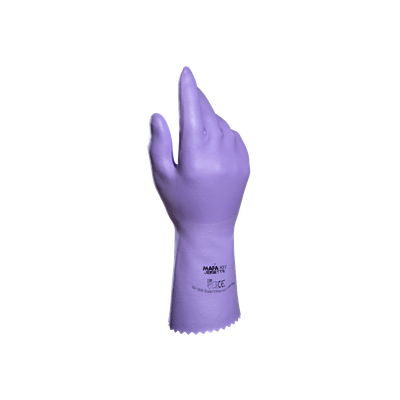Alto 258
Strong protection against aggressive concentrated detergents
-
CAT. 3
 0334
0334
-
 1X10X
1X10X
-
Type B
 KPS
KPS
-

-

Specific advantages
 Comfort
Comfort
- Added comfort and absorption of perspiration, due to the cotton flock-lining
 Productivity
Productivity
- Good handling of slippery objects, due to the embossed texture
 Skin protection
Skin protection
- Good resistance to many diluted acids
Applications
Mechanical industry
- Assembly of small, oil and grease free parts
- Minor maintenance Tasks
Chemical industry
- Common handling Tasks
Aeronautics industry
- Work with composite materials (resins)
Product detail
| Material | Natural latex |
|---|---|
| Colour | yellow |
| Interior finish | Flocked |
| Exterior finish | Embossed texture |
| Length (cm) | 32 |
| Thickness (mm) | 0.6 |
| Size | 6 7 8 9 10 |
| Packaging | 1 pair/bag 10 pairs/box 100 pairs/carton |
Chemical chart
OVERALL CHEMICAL PROTECTION RATING
Protection rating is determined by taking into account the effects of both permeation and degradation in an attempt to provide users with an overall protection guideline when using our glove products against specific chemicals.
Meaning of the colours :
The chemical test data and overall chemical protection rating should not be used as the absolute basis for glove selection. Actual in-use conditions may vary glove performance from the controlled conditions of laboratory tests. Factors other than chemical contact time
| Chemical Product | CAS # | Breakthrough time (minutes) |
Permeation level |
Standard | Degradation level |
Rating |
|---|---|---|---|---|---|---|
| 1,1,1-Trichloroethane 99% | 71-55-6 | 10 | 0 | EN 374-3:2003 | 1 |
|
| 2-Nitropropane 99% | 79-46-9 | 18 | 1 | EN 374-3:2003 | 3 |
|
| 2-Propanol (Isopropanol) 99% | 67-63-0 | 40 | 2 | EN 374-3:2003 | 4 |
|
| Acetic acid 99% | 64-19-7 | 21 | 1 | EN 374-3:2003 | 3 |
|
| Acetone 99% | 67-64-1 | 5 | 0 | EN 374-3:2003 | 3 |
|
| Butyl Acetate 99% | 123-86-4 | 10 | 0 | EN 374-3:2003 | 2 |
|
| Cyclohexane 99% | 110-82-7 | 7 | 0 | EN 374-3:2003 | 1 |
|
| Dimethylformamide 99% | 68-12-2 | 30 | 1 | EN 374-3:2003 | 4 |
|
| Dimethylsulfoxide 99% | 67-68-5 | 190 | 4 | EN 374-3:2003 | 4 |
|
| Ethanol 95% | 64-17-5 | 17 | 1 | EN 374-3:2003 | 3 |
|
| Ethyl acetate 99% | 141-78-6 | 3 | 0 | EN 374-3:2003 | 2 |
|
| Formaldehyde 37% | 50-00-0 | >480 | 6 | EN 16523-1:2015 | NT |
|
| Hydrochloric acid 10% | 7647-01-0 | >480 | 6 | EN 374-3:2003 | NT |
|
| Hydrochloric acid 35% | 7647-01-0 | >480 | 6 | EN 374-3:2003 | NT |
|
| Hydrofluoric Acid 40% | 7664-39-3 | >480 | 6 | EN 16523-1:2015 | NT |
|
| Hydrogen peroxide 30% | 7722-84-1 | >480 | 6 | EN 16523-1:2015 | 4 |
|
| Methanol 99% | 67-56-1 | 26 | 1 | EN 374-3:2003 | 3 |
|
| Methyl Ethyl Ketone (2-Butanone) 99% | 78-93-3 | 6 | 0 | EN 374-3:2003 | 3 |
|
| Methyl methacrylate 95% | 80-62-6 | 5 | 0 | EN 374-3:2003 | 3 |
|
| Methylisobutylketone 99% | 108-10-1 | 6 | 0 | EN 374-3:2003 | 3 |
|
| N-methyl-2-Pyrrolidone 99% | 872-50-4 | 60 | 2 | EN 374-3:2003 | 4 |
|
| Naphtha, Hydrotreated Heavy mixture | 64742-48-9 | 7 | 0 | EN 374-3:2003 | 1 |
|
| Phosphoric acid 75% | 7664-38-2 | >480 | 6 | EN 374-3:2003 | 4 |
|
| Sodium hydroxide 20% | 1310-73-2 | >480 | 6 | EN 374-3:2003 | NT |
|
| Sodium hydroxide 40% | 1310-73-2 | >480 | 6 | EN 16523-1:2015 | 3 |
|
| Sodium hydroxide 50% | 1310-73-2 | >480 | 6 | EN 374-3:2003 | NT |
|
| Styrene 99% | 100-42-5 | 2 | 0 | EN 374-3:2003 | 1 |
|
| Sulfuric acid 96% | 7664-93-9 | 83 | 3 | EN 374-3:2003 | NT |
|
| t-Butyl Methyl Ether 98% | 1634-04-4 | 8 | 0 | EN 374-3:2003 | 2 |
|
| Tetrahydrofurane 99% | 109-99-9 | 2 | 0 | EN 374-3:2003 | 1 |
|
| Toluene 99% | 108-88-3 | 6 | 0 | EN 374-3:2003 | 1 |
|
| Trichloroethylene 99% | 79-01-6 | 1 | 0 | EN 374-3:2003 | 1 |
|
| Vinyl acetate 99% | 108-05-4 | 3 | 0 | EN 374-3:2003 | 3 |
|
| Xylene 99% | 1330-20-7 | 4 | 0 | EN 374-3:2003 | 1 |
|
*not normalized result
More gloves

Harpon 325
Comfort and safety when gripping heavy, rough or slippery objects in highly aggressive environments

Jersette 307
Exceptional comfort and precision dexterity in light aggressive environments

Harpon 326
Comfort and safety when gripping heavy, rough or slippery objects in food industry



